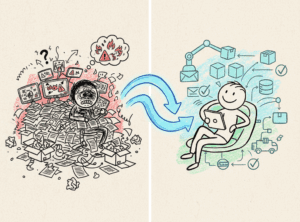AI is everywhere in E-Commerce right now, but most small and medium businesses end up disappointed by their first round of AI projects. I’ve seen it happen several times already with different clients. Companies feel the pressure to “do something with AI” because everyone else is, but they end up throwing money at solutions that don’t move the needle.
The stakes are real. According to recent data, while SMB AI adoption jumped from 14% to 39% in just one year, only 1% of companies actually succeed at scaling AI beyond pilot phases. That’s a pretty sobering stat.
Let’s break down the 7 most common mistakes I see E-Commerce businesses making so you can avoid these expensive traps.
Mistake #1: Chasing AI Hype Without a Real Use Case
This one drives me crazy because I keep seeing it happen. Companies get excited about AI tools and jump in headfirst without identifying what problem they’re actually trying to solve.
Here’s a perfect example I’ve witnessed recently – one manager, clearly out of his depth but wanting to look like he was “on the ball,” simply told his IT department that he wanted to implement Microsoft Co-Pilot for a number of his staff. While Co-Pilot can do some things for a company, it feels like it was crudely shoe-horned into the Office Suite, poorly executed, and WAY overpriced.
There are much more effective tools out there to increase productivity for much cheaper (I’ll cover some of these in a future post). Microsoft seems to be playing on the desire for AI by offering this poorly-executed product. They’re capitalizing on that fear of missing out that many business owners feel right now.
What this looks like in practice:
- Buying a chatbot before fixing your customer support processes
- Implementing AI-powered inventory forecasting when your real issue is poor demand planning
- Adding AI product recommendations when your conversion funnel is broken
The better approach? Start with your business pain points. What’s keeping you up at night? What manual processes are eating up your team’s time? Then – and only then – look for AI tools that specifically address those issues.
(Have you had a different experience with Co-Pilot? I’d love to hear your thoughts in the comments below.)
Mistake #2: Poor Integration and Choosing the Wrong Tools
This mistake actually has two parts, and they’re both killers.
First, there’s the integration nightmare. I see businesses drop AI tools on top of their existing tech stack like they’re adding sprinkles to ice cream. But that’s not how it works. These tools need to talk to each other, or you end up with more silos and manual work than when you started.
Picture this – you’ve got an AI inventory forecasting tool that’s feeding data from your outdated ERP system. The forecast looks great on paper, but it’s based on garbage data. You’re making decisions with confidence, but you’re confidently wrong.
The second part is choosing the wrong tool entirely. Too many businesses follow trends instead of doing their research. They see a competitor using a flashy AI platform and assume it’s right for them too.
Before choosing any AI tool, research:
- How well it integrates with your existing systems
- What your actual data requirements are
- Whether the tool’s capabilities match your specific needs
- The total cost of ownership, not just the monthly subscription
- What level of technical expertise you’ll need to maintain it
Don’t just pick what’s popular. Pick what’s right for your business, your team, and your technical capabilities.
Mistake #3: Lack of Staff Training & Change Management
Here’s something that might surprise you – the technology isn’t usually the hard part. It’s the people.
I’ve seen companies spend thousands on AI tools, then expect their teams to just figure it out. No training, no change management, no clear incentives to actually use the new systems. Guess what happens? Three months later, everyone’s back to their old manual processes, and that expensive AI tool is collecting digital dust.
What successful AI adoption looks like:
- Proper onboarding and training for all users
- Clear documentation and best practices
- Change champions within your team who can help others
- Incentives that reward adoption and effective use
- Regular check-ins to troubleshoot issues early
Remember, you’re not just implementing technology – you’re changing how people work. That requires intentional change management.
Mistake #4: Ignoring Data Quality & Expecting AI to Do Everything
This is where I need to call out the lazy AI users. I’m seeing way too many people trying to get AI to do work for them on subjects they know nothing about, rather than collaborating with the technology.
Here’s the hard truth – AI can’t magically fix bad data or compensate for your lack of knowledge. If you’re feeding it incomplete product descriptions, inconsistent order histories, or missing customer data, you’re going to get garbage results. And if you don’t understand your business well enough to guide the AI, you’re setting yourself up for failure.
The best work I’ve seen produced with AI is collaborative, based on the user’s own expertise and learnings. You can’t just be lazy and expect the machine to do your thinking for you.
A recent survey showed that the top concern about AI is the poor quality being produced. But here’s the thing – that’s not an AI problem, that’s a user problem. When someone who doesn’t understand E-Commerce operations tries to use AI to optimize their supply chain, of course the results are going to be poor.
The collaboration approach that actually works:
- Clean and organize your data before feeding it to AI tools
- Understand your business processes deeply so you can guide the AI effectively
- Review and refine AI outputs based on your expertise
- Use AI to augment your knowledge, not replace it
- Set up proper data validation and quality checks
AI is powerful, but it’s not magic. It needs good data and smart humans to produce good results.
Mistake #5: Automating Before Optimizing the Offline Process
This one makes me shake my head every time I see it. Companies try to “AI-ify” broken processes instead of fixing the root cause first. It’s like putting a turbo engine in a car with flat tires – you’re still not going to get where you want to go.
I once worked with a client who wanted to implement AI-powered dynamic pricing. Sounds smart, right? The problem was, their inventory management was a complete mess. The AI was making pricing decisions based on inaccurate stock levels and outdated product information. They were automating chaos.
Fix the process first, then automate:
- Map out your current workflows and identify bottlenecks
- Standardize procedures and eliminate redundancies
- Ensure data accuracy and consistency
- Test the optimized process manually before adding AI
- Only then layer on automation and AI enhancements
Remember, AI will amplify whatever you feed it. If your process is broken, AI will just break it faster and at scale.
Mistake #6: Over-Prioritizing Automation Over Customer Experience
Here’s one that I’ve made myself – a couple of times, I have to admit. In the rush to implement AI, we focused so heavily on efficiency gains that we forget about the customer experience. We ended up with robotic email responses, tone-deaf product recommendations, and support bots that frustrated more than they helped.
I’ve also seen this play out in E-Commerce stores where the AI-powered email campaigns were technically impressive but felt completely impersonal. Open rates went down, customer complaints went up, and the brand reputation took a hit.
And although the AI behind the mistakes that I pointed out above has gotten better and better, it still needs to be monitored.
Signs you’ve gone too far with automation:
- Customer complaints about impersonal service
- Decreased engagement with automated touchpoints
- Support tickets increasing due to bot failures
- Loss of the human touch that differentiated your brand
The goal isn’t to remove humans from the equation – it’s to free them up to focus on higher-value interactions while AI handles the routine stuff. Keep the customer experience at the certre of your AI strategy.
Mistake #7: Failing to Measure the Right Outcomes
This might be the most common mistake of all. Companies implement AI tools but don’t set up proper measurement frameworks to track whether they’re actually delivering value. They measure activity instead of results.
I see businesses celebrating because their AI chatbot handled 500 conversations last month. But did those conversations lead to sales? Did customer satisfaction improve? Did support costs actually decrease? Without the right metrics, you’re flying blind.
Feels similar to back in the day when we would celebrate Facebook likes for businesses – costly, challenging, but ultimately pretty fruitless.
What to measure instead:
- Revenue impact from AI-driven recommendations
- Time saved on specific processes (quantified in hours and dollars)
- Customer satisfaction scores for AI-powered touchpoints
- Conversion rate improvements from AI optimizations
- Cost reduction in specific operational areas
- Error rates before and after AI implementation
Set up simple before-and-after comparisons that tie back to your bottom line. If you can’t measure the impact, you can’t manage the investment.
How to Avoid These Mistakes: Your Quick Playbook
Here’s your roadmap to better AI adoption:
- Start with business pain, not AI capabilities – Identify your biggest operational headaches first
- Clean your data house – AI is only as good as the data you feed it
- Choose tools that integrate well – Research compatibility before you buy
- Invest in training – Your team needs to understand how to work with AI effectively
- Pilot with clear metrics – Set measurable goals before you implement
- Keep customers at the center – Don’t sacrifice experience for efficiency
- Measure results, not activity – Track business outcomes, not just usage stats
The Bottom Line
AI can absolutely help your E-Commerce business grow and become more efficient. But only if you avoid these hidden traps that catch most small and medium businesses off guard.
The companies that succeed with AI are the ones that treat it as a collaborative tool, not a magic wand. They do the hard work of understanding their processes, cleaning their data, and training their teams. They measure what matters and keep their customers’ needs front and centre.
Don’t let the pressure to “do AI” push you into expensive mistakes. Take a strategic approach, start small, and build from there.
Have you made any of these mistakes? Or do you have a different take on AI adoption? Share your thoughts in the comments below – I read every one.





